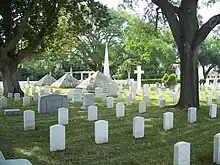St. Augustine National Cemetery
St. Augustine National Cemetery is a United States National Cemetery located in the city of St. Augustine in St. Johns County, Florida. Located on the grounds of the active military installation known as St. Francis Barracks, the state headquarters of the Florida National Guard, it encompasses 1.4 acres (0.57 ha), and as of the end of 2005 had 2,788 interments. Administered by the United States Department of Veterans Affairs, it is currently closed to new interments. It was listed on the National Register of Historic Places in 2016.
| St. Augustine National Cemetery | |
|---|---|
 Headstones with Victorian homes of St. Francis Barracks in the background. | |
| Details | |
| Established | 1828 |
| Location | |
| Country | United States |
| Coordinates | 29°53′10″N 81°18′35″W |
| Type | United States National Cemetery (closed to new interments) |
| Owned by | U.S. Department of Veterans Affairs |
| Size | 1.4 acres (0.57 ha) |
| No. of interments | 2,788 |
| Website | Official |
| Find a Grave | St. Augustine National Cemetery |
History
The first interment took place in the area of the cemetery in 1828 it was then used as the post cemetery for the St. Francis Barracks. The first burials were soldiers stationed at St. Francis Barracks and veterans of the Indian Wars, including many that were transferred from burial grounds in what was then Seminole controlled territory.
During the American Civil War, St. Augustine was initially claimed by the Confederacy, but was quickly occupied by Union forces and remained in Union hands for the remainder of the war. After the war, the cemetery was expanded and improved, and in 1881 it became a National Cemetery.
The cemetery also contains the graves of five British Commonwealth servicemen of World War II, a soldier of the Royal Corps of Signals and four aviation officers of the Royal Naval Volunteer Reserve.[1]
St. Augustine National Cemetery was included in a National Historic Landmark historic district that encompasses the oldest part of the city in 1970.
Notable monuments

- The Dade Monument, three coquina pyramids erected in 1842 to mark the end of the second of the Seminole Wars. Beneath them are the remains of 1,468 soldiers who died during the wars.
Notable interments
- Major Francis L. Dade (1792–1835), namesake of Dade County, Missouri, Miami-Dade County, Florida, and Dade County, Georgia, veteran of the Indian Wars.[2]
- Brigadier General Martin Davis Hardin (1837–1923), Civil War Union general
References
- CWGC Cemetery report. Breakdown obtained from casualty record.
- Cemetery profile at nps.gov
External links
- National Cemetery Administration
- St. Augustine National Cemetery
- Historic American Landscapes Survey (HALS) No. FL-3, "Saint Augustine National Cemetery, 104 Marine Street, Saint Augustine, St. Johns County, FL", 55 photos, 5 photo caption pages
- U.S. Geological Survey Geographic Names Information System: Saint Augustine National Cemetery
- Saint Augustine National Cemetery at Find a Grave